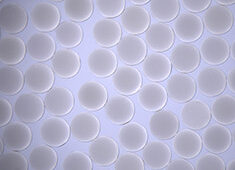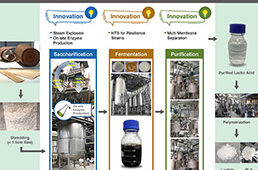Cells ingest things by engulfing them. When a long perpendicular fiber comes near, the cell senses only its tip, mistakes it for a sphere, and begins engulfing something too long to handle. Image: Gao Lab/Brown University |
It’s been long known that asbestos spells trouble for human cells.
Scientists have seen cells stabbed with spiky, long asbestos fibers, and the
image is gory: Part of the fiber is protruding from the cell, like a quivering
arrow that’s found its mark.
But scientists had been unable to understand why cells would be interested
in asbestos fibers and other materials at the nanoscale that are too long to be
fully ingested. Now a group of researchers at Brown University
explains what happens. Through molecular simulations and experiments, the team
reports in Nature
Nanotechnology that certain nanomaterials, such as carbon
nanotubes, enter cells tip-first and almost always at a 90-degree angle. The
orientation ends up fooling the cell; by taking in the rounded tip first, the
cell mistakes the particle for a sphere, rather than a long cylinder. By the
time the cell realizes the material is too long to be fully ingested, it’s too
late.
“It’s as if we would eat a lollipop that’s longer than us,” says Huajian
Gao, professor of engineering at Brown and the paper’s corresponding author. “It would get stuck.”
The research is important because nanomaterials like carbon nanotubes have
promise in medicine, such as acting as vehicles to transport drugs to specific
cells or to specific locations in the human body. If scientists can fully
understand how nanomaterials interact with cells, then they can conceivably
design products that help cells rather than harm them.
“If we can fully understand (nanomaterial-cell dynamics), we can make other
tubes that can control how cells interact with nanomaterials and not be toxic,”
Gao says. “We ultimately want to stop the attraction between the nanotip and
the cell.”
Like asbestos fibers, commercially available carbon nanotubes and gold
nanowires have rounded tips that often range from 10 to 100 nm in diameter.
Size is important here; the diameter fits well within the cell’s parameters for
what it can handle. Brushing up against the nanotube, special proteins called
receptors on the cell spring into action, clustering and bending the membrane
wall to wrap the cell around the nanotube tip in a sequence that the authors
call “tip recognition.” As this occurs, the nanotube is tipped to a 90-degree
angle, which reduces the amount of energy needed for the cell to engulf the
particle.
Once the engulfing—endocytosis—begins, there is no turning back. Within
minutes, the cell senses it can’t fully engulf the nanostructure and
essentially dials 911. “At this stage, it’s too late,” Gao says. “It’s in
trouble and calls for help, triggering an immune response that can cause
repeated inflammation.”
The team hypothesized the interaction using coarse-grained molecular
dynamic simulations and capped multiwalled carbon nanotubes. In experiments
involving nanotubes and gold nanowires and mouse liver cells and human
mesothelial cells, the nanomaterials entered the cells tip-first and at a 90-degree
angle about 90% of the time, the researchers report.
“We thought the tube was going to lie on the cell membrane to obtain more
binding sites. However, our simulations revealed the tube steadily rotating to
a high-entry degree, with its tip being fully wrapped,” says Xinghua Shi, first
author on the paper who earned his doctorate at Brown and is at the Chinese Academy
of Sciences in Beijing. “It is counter-intuitive and is mainly due to the bending energy release as the
membrane is wrapping the tube.”
The team would like to study whether nanotubes without rounded tips—or less
rigid nanomaterials such as nanoribbons—pose the same dilemma for cells.
“Interestingly, if the rounded
tip of a carbon nanotube is cut off (meaning the tube is open and hollow), the
tube lies on the cell membrane, instead of entering the cell at a
high-degree-angle,” Shi says.





